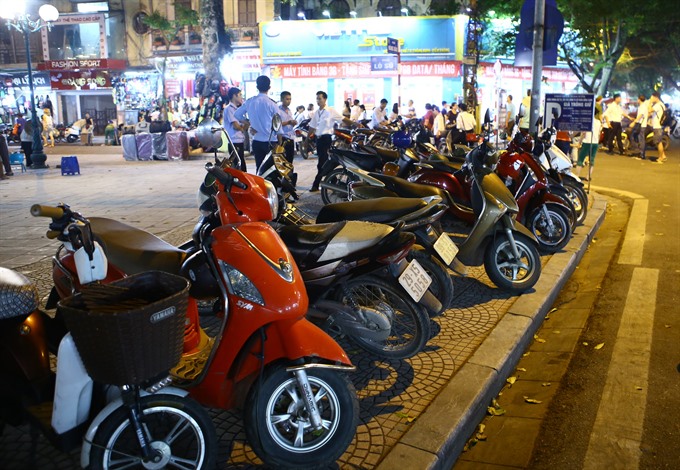 Society
Society

About 60,000 sq.m of pavements in the central districts of Hà Nội are being misused as parking areas, blocking pedestrians and degrading footpath quality, Tiền Phong (Vanguard) newspaper reports.
 |
| A motorbike parking lot on Hàng Dầu Street in Hà Nội. - VNA/VNS Photo |
HÀ NỘI — About 60,000 sq.m of pavements in the central districts of Hà Nội are being misused as parking areas, blocking pedestrians and degrading footpath quality, Tiền Phong (Vanguard) newspaper reports.
The capital city’s parking lots currently meet the demand of only about 10 per cent of all vehicles. Due to the shortage, district authorities have allowed organizations and companies to run parking lots on large areas of pavements.
In Hoàn Kiếm District for example, the local People’s Committee licensed 220 parking lots on pavements covering more than 26,000 sq.m, including 220 motorbike parking lots and 40 car parking lots.
Associate Professor Nguyễn Quang Đạo from Việt Nam Bridge and Road Association said that the pavements were designed to serve pedestrians and not to carry 1.5 to 3 tonne-cars. The bricks and stone squares carrying heavy loads will eventually sink and break into pieces.
“This is the main reason why newly paved sidewalks in many Hà Nội streets have sunk and broken,” he said.
Nguyễn Văn Dư, a transport expert with Japan International Co-operation Agency, said that pavement construction work was designed to last at least 20 to 25 years.
He said that in recent years, Hà Nội pavements had to be repaired every two to three years. He called for a review of pavement use and management.
Building parking lots on pavements went against construction and urban planning rules, he said.
Since 2010, Hà Nội pavements have experienced three major changes. In 2010, reddish paving bricks in the central districts were replaced by block paving bricks. In 2013-2014, the pavements were replaced by bricks that looked like stone. Two years later, hundreds of them were broken.
Trịnh Hoàng Tùng, director of Hoàn Kiếm District’s construction and investment projects, said that most pavements in the district were degraded. The block paving was easily damaged and would last only two to three years.
At the beginning of the year, the city planned to pave 936 streets with natural stone in 12 districts across Hà Nội by 2020.
Each square metre of natural stone is worth VNĐ1.7 million (US$74). It takes VNĐ200 billion ($8.7 million) in total to pave more than 100,000 sq.m of pavements in four central districts.
According to experts, natural stone’s biggest asset is its reliability. They say it should last for up to 70 years.However, experts are worried that the pavement parking lots will damage them and cause a huge waste.
Tùng said that repaving sidewalks many times was not only a waste, but also turned the city into a construction site.
In some districts, it is reported that pavements in good condition have been repaved with natural stone, Trần Việt Trung, deputy director of Hà Nội’s Transport Department told Tiền Phong (Vanguard) newspaper.
The quality of paving stones depends on the quality of the concrete layer below. The city has asked districts to review quality of pavements and not to repave those still in good condition, he said. — VNS
Hà Nội’s People’s Committee proposes to increase on-street parking fees by up to three times.Accordingly, the current motorbike parking fee imposed since 2012 is VNĐ45,000 ($2) per sq.m per month. This is likely to rise to VNĐ135,000 ($5.80) per sq.m per month. The highest fee for car parking is currently VNĐ80,000 ($3.5) per sq.m per month. The new rate will be up to VNĐ240,000 ($10). The proposal will be discussed at a meeting of the city’s People’s Council early next month. In 2016, on-street parking services collected nearly VNĐ39 billion ($1.7 million). The fees collected in the first nine months of this year totals nearly VNĐ30 billion ($1.3 million). If the proposal is approved, the expected on-street parking fees collected in 2018 will be more than VNĐ113 billion ($4.9 million). |